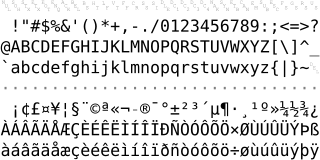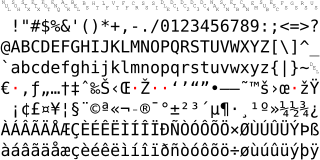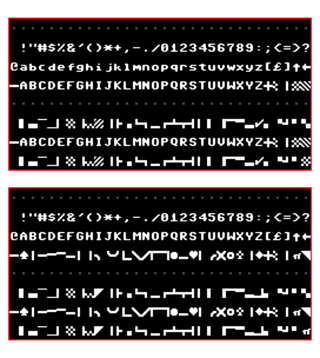Related Research Articles

ISO/IEC 8859-1:1998, Information technology — 8-bit single-byte coded graphic character sets — Part 1: Latin alphabet No. 1, is part of the ISO/IEC 8859 series of ASCII-based standard character encodings, first edition published in 1987. ISO/IEC 8859-1 encodes what it refers to as "Latin alphabet no. 1", consisting of 191 characters from the Latin script. This character-encoding scheme is used throughout the Americas, Western Europe, Oceania, and much of Africa. It is the basis for some popular 8-bit character sets and the first two blocks of characters in Unicode.
ISO/IEC 8859 is a joint ISO and IEC series of standards for 8-bit character encodings. The series of standards consists of numbered parts, such as ISO/IEC 8859-1, ISO/IEC 8859-2, etc. There are 15 parts, excluding the abandoned ISO/IEC 8859-12. The ISO working group maintaining this series of standards has been disbanded.
ISO/IEC 8859-3:1999, Information technology — 8-bit single-byte coded graphic character sets — Part 3: Latin alphabet No. 3, is part of the ISO/IEC 8859 series of ASCII-based standard character encodings, first edition published in 1988. It is informally referred to as Latin-3 or South European. It was designed to cover Turkish, Maltese and Esperanto, though the introduction of ISO/IEC 8859-9 superseded it for Turkish. The encoding was popular for users of Esperanto, but fell out of use as application support for Unicode became more common.

In German orthography, the letter ß, called Eszett or scharfes S, represents the phoneme in Standard German when following long vowels and diphthongs. The letter-name Eszett combines the names of the letters of ⟨s⟩ and ⟨z⟩ in German. The character's Unicode names in English are sharp s and eszett. The Eszett letter is used only in German, and can be typographically replaced with the double-s digraph ⟨ss⟩, if the ß-character is unavailable. In the 20th century, the ß-character was replaced with ss in the spelling of Swiss Standard German, while remaining Standard German spelling in other varieties of the German language.

Windows-1252 or CP-1252 is a single-byte character encoding of the Latin alphabet that was used by default in Microsoft Windows for English and many Romance and Germanic languages including Spanish, Portuguese, French, and German. This character-encoding scheme is used throughout the Americas, Western Europe, Oceania, and much of Africa.
ISO/IEC 8859-11:2001, Information technology — 8-bit single-byte coded graphic character sets — Part 11: Latin/Thai alphabet, is part of the ISO/IEC 8859 series of ASCII-based standard character encodings, first edition published in 2001. It is informally referred to as Latin/Thai. It is nearly identical to the national Thai standard TIS-620 (1990). The sole difference is that ISO/IEC 8859-11 allocates non-breaking space to code 0xA0, while TIS-620 leaves it undefined.
ISO/IEC 8859-8, Information technology — 8-bit single-byte coded graphic character sets — Part 8: Latin/Hebrew alphabet, is part of the ISO/IEC 8859 series of ASCII-based standard character encodings. ISO/IEC 8859-8:1999 from 1999 represents its second and current revision, preceded by the first edition ISO/IEC 8859-8:1988 in 1988. It is informally referred to as Latin/Hebrew. ISO/IEC 8859-8 covers all the Hebrew letters, but no Hebrew vowel signs. IBM assigned code page 916 to it. This character set was also adopted by Israeli Standard SI1311:2002, with some extensions.
ISO/IEC 8859-5:1999, Information technology — 8-bit single-byte coded graphic character sets — Part 5: Latin/Cyrillic alphabet, is part of the ISO/IEC 8859 series of ASCII-based standard character encodings, first edition published in 1988. It is informally referred to as Latin/Cyrillic.

PETSCII, also known as CBM ASCII, is the character set used in Commodore Business Machines' 8-bit home computers.

Michael Everson is an American and Irish linguist, script encoder, typesetter, type designer and publisher. He runs a publishing company called Evertype, through which he has published over a hundred books since 2006.

ArmSCII or ARMSCII is a set of obsolete single-byte character encodings for the Armenian alphabet defined by Armenian national standard 166–9. ArmSCII is an acronym for Armenian Standard Code for Information Interchange, similar to ASCII for the American standard. It has been superseded by the Unicode standard.
The Universal Coded Character Set is a standard set of characters defined by the international standard ISO/IEC 10646, Information technology — Universal Coded Character Set (UCS), which is the basis of many character encodings, improving as characters from previously unrepresented typing systems are added.

The Atari ST character set is the character set of the Atari ST personal computer family including the Atari STE, TT and Falcon. It is based on code page 437, the original character set of the IBM PC.
MSX character sets are a group of single- and double-byte character sets developed by Microsoft for MSX computers. They are based on code page 437.
The TRS-80 computer manufacturered by Tandy / Radio Shack contains an 8-bit character set. It is partially derived from ASCII, and shares the code points from 32 - 95 on the standard model. Code points 96 - 127 are supported on models that have been fitted with a lower-case upgrade.
This article covers technical details of the character encoding system defined by ETS 300 706, a standard for World System Teletext, and used for the Viewdata and Teletext variants of Videotex in Europe.
Sharp MZ character sets are character sets made by Sharp Corporation for Sharp MZ computers. The European and Japanese versions of the software use different character sets.
Symbols for Legacy Computing is a Unicode block containing graphic characters that were used for various home computers from the 1970s and 1980s and in Teletext broadcasting standards. It includes characters from the Amstrad CPC, MSX, Mattel Aquarius, RISC OS, MouseText, Atari ST, TRS-80 Color Computer, Oric, Texas Instruments TI-99/4A, TRS-80, Minitel, Teletext, ATASCII, PETSCII, ZX80, and ZX81 character sets, as well as semigraphics characters.
The Amstrad CPC character set is the character set used in the Amstrad CPC series of 8-bit personal computers when running BASIC. This character set existed in the built-in "lower" ROM chip. It is based on ASCII-1967, with the exception of character 0x5E which is the up arrow instead of the circumflex, as it is in ASCII-1963, a feature shared with other character sets of the time. Apart from the standard printable ASCII range (0x20-0x7e), it is completely different from the Amstrad CP/M Plus character set. The BASIC character set had symbols of particular use in games and home computing, while the CP/M Plus character reflected the International and Business flavor of the CP/M Plus environment. This character set is represented in Unicode as of the March 2020 release of Unicode 13.0, which added symbols for legacy computing.
References
- 1 2 3 4 5 Avis, Ed (2001-03-08). "Acorn RISC OS". Archived from the original on 2020-08-06. Retrieved 2020-03-30.
- ↑ "7. Characters not proposed", L2/19-025: Proposal to add characters from legacy computers and teletext to the UCS (PDF), 2019-01-04
- ↑ "ReadMe.txt" (PDF), L2/19-025: Proposal to add characters from legacy computers and teletext to the UCS, 2019-01-04
- ↑ "RISCOSV.TXT" (PDF), L2/19-025: Proposal to add characters from legacy computers and teletext to the UCS, 2019-01-04
- ↑ "RISCOSI.TXT" (PDF), L2/19-025: Proposal to add characters from legacy computers and teletext to the UCS, 2019-01-04
- ↑ "RISCEFF.TXT" (PDF), L2/19-025: Proposal to add characters from legacy computers and teletext to the UCS, 2019-01-04